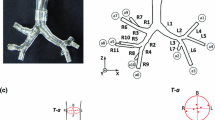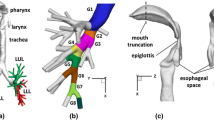Abstract
Computational fluid dynamics (CFD) has been used to investigate the flow of air through the human orotracheal system. Results from an idealised geometry, and from a patient-specific geometry created from MRI scans were compared. The results showed a significant difference in the flow structures between the two geometries. Inert particles with diameters in the range 1–9 μm were tracked through the two geometries. Particle diameter has proved to be an important factor in defining the eventual destinations of inhaled particles. Results from our calculations match other experimental and computational results in the literature, and differences between the idealised and patient-specific geometries are less significant.







Similar content being viewed by others
References
Barbini A, Brighenti C, Cevenini G, Gnudi G (2005) A dynamic morphometric model of the normal lung for studying expiratory flow limitation in mechanical ventilation. Ann Biomed Eng 33(4):518–530
Cebral JR, Löhner R (2001) From medical images to anatomically accurate finite element grids. Int J Numer Meth Eng 51:985–1008
Gosman AD, Ioannides E (1983) Aspects of computer simulation of liquid-fueled combustors. J Energy 7(6):482–490
Green A (2004) Modelling of peak-flow wall shear stress in major airways of the lung. J Biomech 37:661–667
Heenan AF, Matilda E, Pollard A, Finlay WH (2003) Experimental measurements and computational modelling of the flow field in an idealised human oropharynx. Exp Fluids 35:70–84
Jin HH, Fan JR, Zeng MJ, Cen KF (2007) Large eddy simulation of inhaled particle deposition within the human upper respiratory tract. J Aerosol Sci 38:257–268
Ladak HM, Milner JS, Steinman DA (2000) Rapid three-dimensional segmentation of the carotid bifurcation from serial mr images. J Biomech Eng T ASME 122(1):96–99
Ma B, Lutchen KA (2006) An anatomically based hybrid computational model of the human lung and its application to low frequency oscillatory mechanics. Ann Biomed Eng 34(11):1691–1704
Mitchell J, Nagel M (2004) Particle size analysis of aerosol from medical inhalers. Kona 22:32–65
Morsi SA, Alexander AJ (1972) An investigation of particle trajectories in two-phase flow systems. J Fluid Mech 55(2):193–208
Nowak N, Kakade P, Annapragada A (2003) Computational fluid dynamics simulation of airflow and aerosol deposition in human lungs. Ann Biomed Eng 31:374–390
Stapleton KW, Guantsch E, Hoskinson M, Finlay WH (2000) On the suitability of k−ε turbulence modelling for aerosol deposition in the mouth and throat: a comparison with experiment. J Aerosol Sci 31:739–749
Tabor G, Young PG, Beresford-West T, Benattayallah A (2007) Mesh construction from medical imaging for multiphysics simulation: Heat transfer and fluid flow in complex geometries. Eng App Comp Fluid Mech 2(1):126–135
Wilcox DC (1994) Simulating transition with a two-equation turbulence model. AIAA J 32:247–255
Author information
Authors and Affiliations
Corresponding author
Rights and permissions
About this article
Cite this article
Collins, T., Tabor, G. & Young, P. A computational fluid dynamics study of inspiratory flow in orotracheal geometries. Med Bio Eng Comput 45, 829–836 (2007). https://doi.org/10.1007/s11517-007-0238-2
Received:
Accepted:
Published:
Issue Date:
DOI: https://doi.org/10.1007/s11517-007-0238-2




